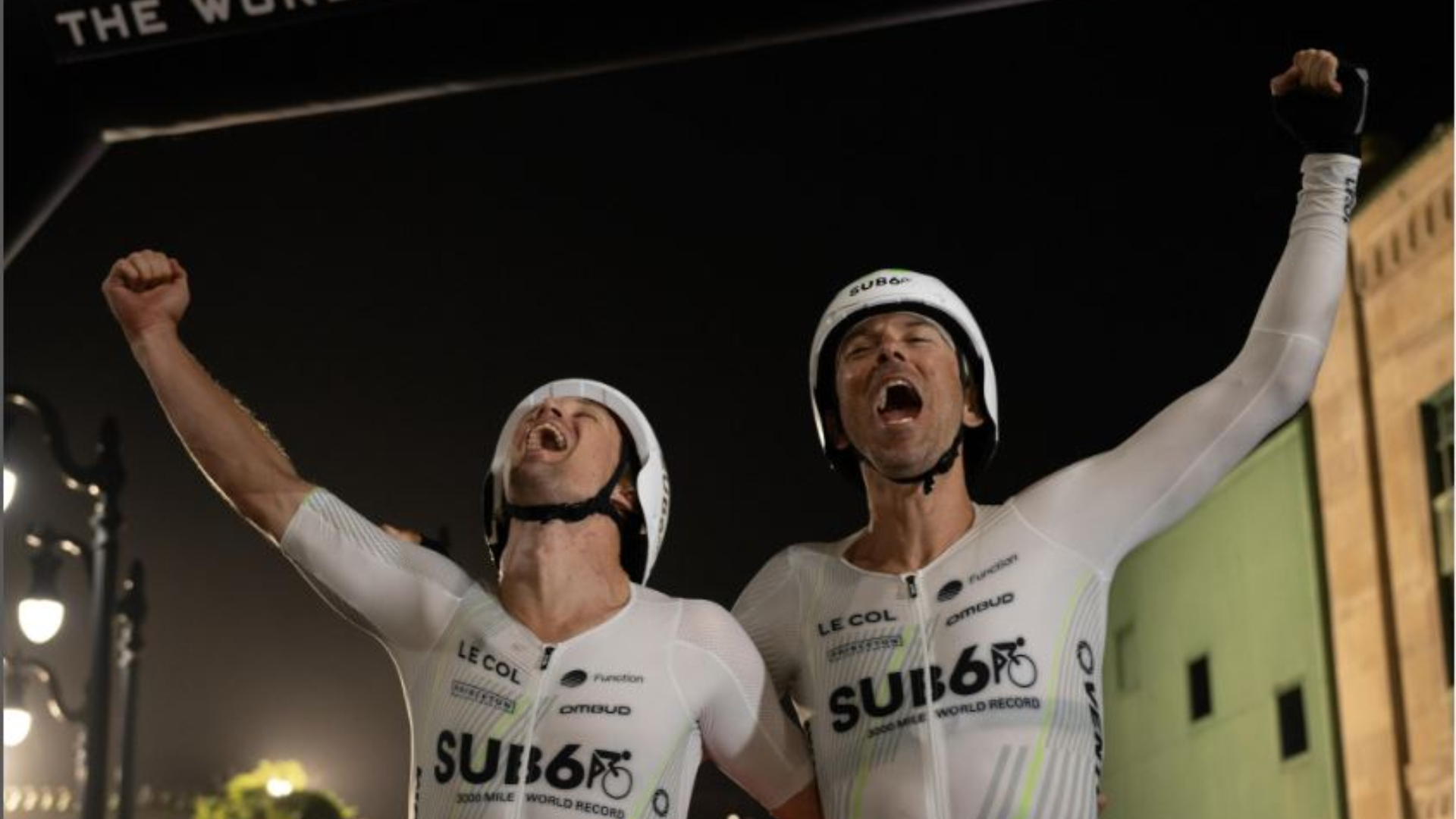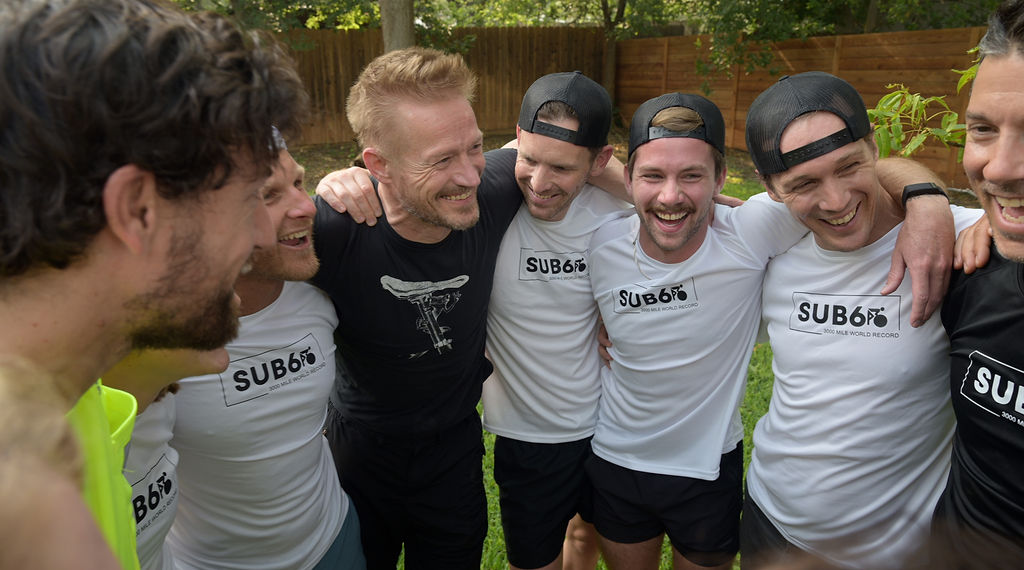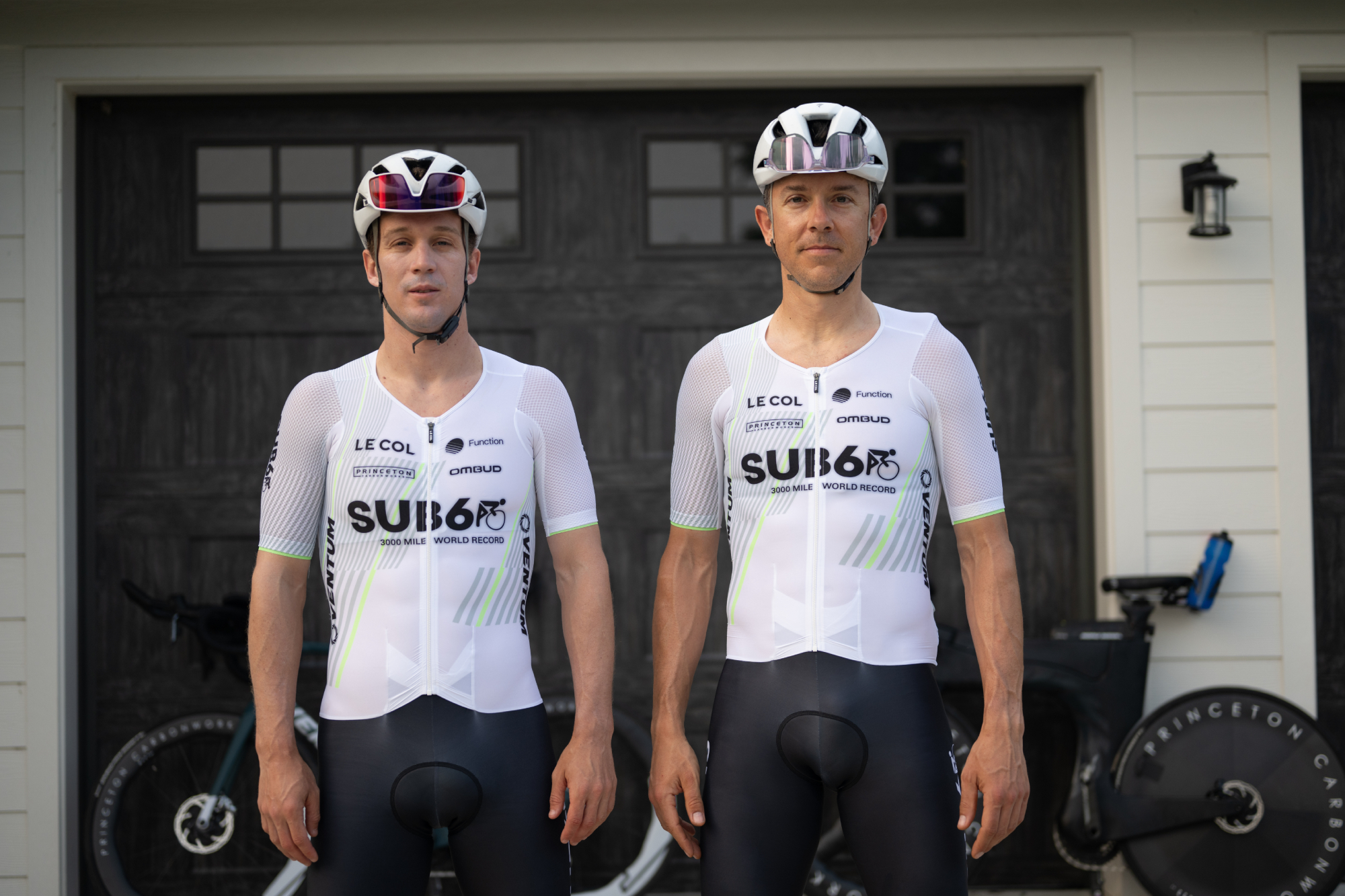New RAAM record: Colin O’Brady and Lucas Clarke complete the 3,064-mile race in 6 days, 6 hours and 43 minutes
It wasn't the "Sub-Six" goal they'd set out for, but a new Race Across America record all the same


When childhood friends Colin O'Brady and Lucas Clarke reached the Race Across America finish line in Atlantic City, New Jersey, on Saturday evening, they may not have fulfilled their "Sub Six" goal, but celebrations were in order all the same.
The duo had left Oceanside, California, on June 15 and spent the following six days conducting a two-person time trial —with each rider completing a 90-minute stint at a time— across the entire width of the United States for a total of 3,064 miles with more than130,000ft of elevation. Averaging 20.33mph, the duo reached the East Coast finish line in 6 days, 6 hours and 43 minutes, shattering the previous record for the pairs category by approximately 5 hours.
"What an adventure. So much to reflect on and share in the days to come, but for now…WE DID IT!," commented an exuberant Colin O'Brady post-race. "To be able to do this with my childhood best friend…wow what a gift!"
In addition to having been best friends since first grade, the two riders have amassed an impressive cache of athletic achievements over the past decades. While not household names in the cycling world per se, O’Brady is a world-renowned adventurer with multiple world records to his name, including the first unsupported crossing of Antarctica by human power and skiing with a 300-pound sled 900 miles across the continent. Lucas Clarke, meanwhile, is one of the top master’s cyclists in the country with three master world track titles to his name. He’s also a former single-speed record holder at the Unbound Gravel 200. RAAM was the first on-the-bike endeavor they've tackled together.
Held since 1982, the Race Across America, or the RAAM as it is most commonly known, is an annual bike race that covers the full width of the United States. Open to amateur and professionals alike, as a team or solo endeavor, the race has been dubbed "the World's Toughest Bicycle Race" as it's several hundred miles longer than the Tour de France and takes please as a single, non-stop stage. No breaks. No transfers. Just continuous pedaling.
Far from being just a two-person endeavor, the record attempt was a full-scale team operation that took over a year to prepare. It involved numerous staff members, multiple bikes, various vehicles, extensive planning, and even wind tunnel testing with world-class equipment.
"This was not just the two of us … turns out the Race Across America is a full contact team sport. I feel humbled to be one member of a fifteen person team that together achieved this success," O'Brady stated. "More than team this group...feels like a family after all we have been through this week. My cup is overflowing with love and gratitude."
The latest race content, interviews, features, reviews and expert buying guides, direct to your inbox!
Read all about the Sub-Six team's effort and year-long pre-race preparations, here.
Going “Sub Six” – which is also the name of their project – would be the fastest time for a RAAM duo by a long way. The current record sits at 6 days and 11 hours, or, more precisely since the actual mileage of the race changes slightly every year, 19.85 miles per hour for the entire crossing.
“We've been friends, best friends, since first grade and we've been doing all kinds of cool stuff together for decades,” Clarke told Cycling Weekly.
Together Clarke and O’Brady have climbed Mount Rainier, done ski mountaineer races and tackled other adventures as a duo but despite O’Brady’s background in triathlon and Clarke’s high level of cycling accomplishments they two have yet to do “something big” on a bike as a unit.Clarke suggested the RAAM last year and that was all it took for the duo to get off the blocks preparing for the challenge.
O’Brady and Clarke may not be household names in the cycling world but both athletes have a huge cache of athletic credentials that has created an elixir perfect for a run at the RAAM record.
O’Brady is a world-renowned adventurer with multiple world records to his name, including the first unsupported crossing of Antarctica by human power and skiing with a 300-pound sled 900 miles across the continent. Lucas Clarke, meanwhile, is one of the top master’s cyclists in the country with three master world track titles to his name. He’s also a former single-speed record holder at the Unbound Gravel 200.
Together, the two found the perfect middle of their shared athletic Venn-diagram with the attempt at the two-person RAAM record.
“For the last 10 years, I have been pretty focused on adventures and pretty extreme environments. From being alone in Antarctica for 54 days, summiting efforts a couple of times, being on K2 in winter and, you know, unfortunately, losing friends from a tragic climbing accident, I’ve been definitely sort of in a life-or-death stakes kind of game, so to speak,” shared O’Brady.
“In most ways, RAAM is a lot different, I will say, as a caveat, I do think riding your bike in the middle of the United States, in the middle of the night, on open roads, is actually quite dangerous, but perhaps not in the same way we think of falling into a crevasse alone in Antarctica, or having getting hit by an avalanche on Everest.”
Zone 2 and wind tunnel testing: finding marginal gains for a 3,000 mile test

When you get into the weeds, the complexities of a RAAM record boil down to three general pillars for success: the endurance of the riding, the equipment choices and the team structure. The effort is fairly straightforward: O’Brady and Clarke will conduct a team relay in which each rider tackles 90-minutes at a time throughout the duration of the trip.
While both riders are extremely fit athletes, riding 90-minute shifts for six straight days is a unique challenge. Both riders will spend very little time above their Zone 2 aerobic levels of output. However, that output will equate to around 36 hours of riding over the 5+ days, which strains parts of the body beyond what most cycling efforts would strain.
For both O’Brady and Lucas, this meant working on neck strengthening akin to that of an F1 driver to sustain the aerodynamic position needed for the race, as well as all the supporting muscles in their upper body and core that support the aerobic system. Nevertheless, the on-the-bike work was fairly simple for both riders as it all revolves around pushing that crucial “all day” power of zone two as high as possible.
The technical aspects of the race and the team construction are more complex and it’s also where huge gains can be made.
The Sub Six project has a full slate of technical partners which includes Princeton Carbonworks, Ventum, and Le Col kit. With the backing of those brand partners, the duo has been able to train for a year on the equipment and tweak it to their individual needs as riders, especially since Clarke is a rider who has a ton of experience in aerodynamics and cycling while O’Brady has very little recent cycling experience.
The team has spared no detail with the two riders spending time in the Silverstone wind tunnel in the UK to optimize all the details of their technical kit. In the world of RAAM, which is mostly contested by amateurs, this amount of commitment is rare.
“Colin worked hard on dialing his position in multiple bike fits, making sure he was comfortable for long rides on the bike. We were able to make some tweaks and add some helmet integration stuff in there, along with working with Le Col on the speed suit development.. So yeah, a lot of that was on me, figuring out the components and whatnot, and bringing that whole package together from a bike standpoin,” Clarke said.
“But, by far, the biggest part of the RAAM is the team dynamic.”
Teamwork makes the RAAM dream work

To be precise, the team will be around 15 people who will be working together to get 2 riders, 2 vans, 8 bikes, 16 wheels and an RV across the country at 20.1 miles per hour. And the clock never stops, with exchanges happening continually every 90 or so minutes, with Clarke likely to take on a slightly bigger workload on the bike given his cycling experience.
Beyond Clarke and O’Brady, the team includes a team director who manages the team of staff, including cooks, mechanics, drivers, a coach, a doctor and a navigator who plots the exchanges and potential obstacles on the road ahead.
“When you think about RAAM you think it's two guys riding bikes,” O’Brady said. “But as I zoomed out a little further on it, and we interviewed a bunch of other people who had completed RAAM, everyone's story was not really about their bike or their fitness. It was all about the logistical components of this project.
“You quickly start to realize you're asking people to take essentially, two weeks out of their lives, away from work, in a van or an RV, and also not sleeping. Like, humans don't necessarily do great under those conditions, either.”
While the race itself is only a 5-6 day event, the Sub Six team has arrived early in Southern California and had a “dress rehearsal” in the Texas Hill country which required the full team to make a second trip together to iron out any kinks or could-be hiccups before the main event.

When the rubber meets the road, RAAM won’t just be a race against the clock. A new record is an exciting goal to strive for, yes, but for O’Brady and Clarke it’s a celebration of a lifelong friendship and having the physical fitness to compete – even as “middle-aged dads.”
“Lucas and I coincidentally walked into a first-grade classroom when I was five years old, and we have been lifelong friends. That’s pretty rare in our culture that pulls us in a million different directions. We've been through so many things together–from the birth of our children to weddings to losing grandparents and losing friends and family. We've grieved, we've laughed, we've adventured. We just have 35 years of life experience together,” O’Brady said.
“So the beauty of this project, and I think that that extends beyond just the six days on the bike, is that setting a big goal together has allowed us to weave the tapestry of our life together throughout the last couple of years. I think there's a really beautiful story about two guys who are not only best friends, but middle-aged dads still being able to push their body at the highest, highest performance and hopefully set a world record.”

Cycling Weekly's North American Editor, Anne-Marije Rook is old school. She holds a degree in journalism and started out as a newspaper reporter — in print! She can even be seen bringing a pen and notepad to the press conference.
Originally from the Netherlands, she grew up a bike commuter and didn't find bike racing until her early twenties when living in Seattle, Washington. Strengthened by the many miles spent darting around Seattle's hilly streets on a steel single speed, Rook's progression in the sport was a quick one. As she competed at the elite level, her journalism career followed, and soon, she became a full-time cycling journalist. She's now been a journalist for two decades, including 12 years in cycling.